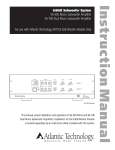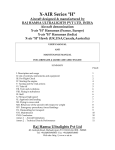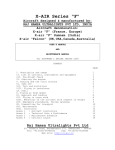Download Atlantic Technology 4.5 PBM Instruction manual
Transcript
Atlantic Technology ® I N N O V A T I V E H O M E T H E A T E R 343 Vanderbilt Avenue Norwood, MA 02062 (781) 762-6300 www.atlantictechnolgy.com Instruction Manual Model 4.5 PBM High Performance Powered Subwoofer Model 4.5 PBM MODEL 4.5 PBM High Performance Powered Subwoofer Congratulations on your purchase of an Atlantic Technology 4.5 PBM powered subwoofer. With proper care, your new subwoofer will provide many years of trouble-free, high quality bass reproduction. The 4.5 PBM is capable of delivering very high output levels and a wide dynamic range with smooth in-room response down to approximately 30 Hz, with a peak SPL of 105dB. The built-in proprietary high-current Class G amplifier is conservatively rated at 150 watts RMS. This amplifier, coupled with the massive 10" long-throw woofer in a sealed, acoustic suspension enclosure, generates musical, accurate deep bass with a minimum of distortion. Your Atlantic Technology powered subwoofer will smoothly integrate with virtually all other brands of loudspeakers on the market. All of its internal electronics have been designed to maintain optimal signal integrity. From the premium quality gold-plated connectors to the clearly marked controls, this is one of the most versatile high performance subwoofers you can buy. An added benefit is its unusually compact size and elegant design. Features Your Atlantic Technology 4.5 PBM powered subwoofer was engineered using the latest technology and finest components available. It features: ● A long-throw 10" driver with a vented motor structure and 2" high temperature voice coil. This powerful driver has a very stiff non-resonant cone that acts as a perfect piston throughout its operating range. Its massive motor assembly and high temperature components mean high performance and exceptional reliability. ● A sealed acoustic suspension enclosure for low distortion and deep bass output. Acoustic suspension designs are inherently low in distortion and naturally deliver deep, smooth bass response. As with all Atlantic Technology subwoofers, we have paid inordinate attention to giving you accurate musical bass reproduction along with terrific special effects. ● A linear power high current discrete Class G amplifier conservatively rated at 150 watts RMS. Atlantic Technology’s advanced Class G amplifiers utilize dual low voltage/high voltage power supplies for exceptional power delivery from a compact, efficient package. One power supply operates during all “normal” demand periods. But when a high demand peak signal appears at the subwoofer input, the second, high voltage supply immediately switches in to dramatically boost the amplifier’s low distortion output capability. The amplifier delivers very high power levels from a compact and efficient package. It consumes less steady-state power and produces much less heat than standard amplifier designs for longer more reliable operation. The 4.5 PBM’s custom designed amplifier has been precision matched to the 10" driver. It exerts accurate and powerful control over the driver for the best performance possible. ○ ○ ○ ○ ○ ○ ○ ○ ○ ○ ○ ○ ○ ○ ○ ○ ○ ○ ○ ○ ○ ○ ○ ○ ○ ○ 2 ○ ○ ○ ○ ○ ○ ○ ○ ○ ○ ○ ○ ○ ○ ○ ○ ○ ○ ○ ○ ○ ○ ○ ○ ○ ○ Atlantic Technology ® ● A useful working frequency range from 30 Hz to 150Hz. ● A Dual Diversity CrossoverTM (DDC) system with an adjustable (50 Hz to 150 Hz) 12 dB per octave low-pass crossover, and a fixed 24 dB per octave “voice filter” at 180 Hz. This unique crossover’s upper end roll-off slope is an extremely steep 12 dB + 24 dB per octave, totaling 36 dB per octave above 180 Hz. It allows for exceptional integration with most any brand or type of speaker on the market. We have developed this unusual design to eliminate any possibility of out-of-band information being audible from the subwoofer and thereby making it localizable. The DDC filter is incorporated in the 4.5 PBM because this subwoofer has been design matched to the Atlantic Technology 4.5 ultra-compact Home Theater speaker system. If you are using the subwoofer with very small satellites (like the 4.5 L /C/ R units) which have limited mid-bass output you have to cross over the subwoofer at a fairly high frequency. Since the 4.5 Left / Right / Center speakers are specifically designed to eliminate all frequencies below 125 Hz, their mating subwoofer must reproduce these sounds. However, it’s critically important that all sounds above this frequency be eliminated from the subwoofer, in order to make for perfect system integration. This is because higher frequencies are your ears’ clues to where sound comes from. The innovative DDC 36 dB crossover in the 4.5 PBM ensures precise and seamless system integration with compact satellite speakers. A subsonic filter is also incorporated to filter out inaudible ultralow frequencies that can rob amplifier power. ● Two line inputs, two line thruputs. The thruputs allow daisy chaining of multiple subwoofers, or can act as a return path back to the processor. ● Two high level inputs, two high level thruputs. These let you connect the subwoofer to your amplifier using the amplifier’s speaker outputs. Once again, you can daisy chain to another subwoofer using the unmodified signal that comes out of the thruput connectors. ● A phase inversion toggle switch (0/180 degrees). This switch allows precise acoustic matching with many systems whose output may be phase reversed. This switch will also allow you to compensate for unusual room acoustics that occur when the woofer is physically separate from the midrange/high frequency units. Be sure to try the Phase switch in both positions whenever you set up the 4.5 PBM or when you change the built-in crossover settings, since the crossover and the Phase switch interact with each other acoustically. ● A front panel variable volume level control. ● Automatic standby operation. Automatic standby features a 7-10 minute turn-off delay and a front panel multi-color LED status indicator. ● An IEC AC power input socket. Your subwoofer comes supplied with a heavy-duty detachable power cord. ● Design and construction to meet all UL/CSA and European safety requirements. ○ ○ ○ ○ ○ ○ ○ ○ ○ ○ ○ ○ ○ ○ ○ ○ ○ ○ ○ ○ ○ ○ ○ ○ ○ ○ 3 ○ ○ ○ ○ ○ ○ ○ ○ ○ ○ ○ ○ ○ ○ ○ ○ ○ ○ ○ ○ ○ ○ ○ ○ ○ ○ Model 4.5 PBM Connecting Your Subwoofer The Atlantic Technology 4.5M Powered Subwoofer is simple to hook up, offering several connection methods for maximum flexibility. Study the system diagrams starting on page 6. Once you have found the example which most closely matches your system, hook up your subwoofer(s) as shown in that diagram. IMPORTANT NOTE: If you are using the complete System 4.5 with a surround processor that includes its own filtered subwoofer output we strongly recommend that you connect the 4.5 PBM to your system using the speaker or high level inputs. This is because most processor internal crossovers are only 12 dB per octave, which is not steep enough for use with the higher crossover levels required for ultra-compact satellites. Only use the low level RCA inputs when the processor outputs unfiltered signals. Should your processor include a 120 Hz or higher crossover, you may connect it to the low level inputs on the 4.5 PBM. When using the recommended high level speaker connections and a discrete 5.1 channel receiver/processor (Dolby Digital, DTS, etc.), set the center channel and surround speakers to the “Small” setting, and the front left and right speakers to “Large.” Figure 1: Amplifier panel and controls for Model 4.5 PBM ○ ○ ○ ○ ○ ○ ○ ○ ○ ○ ○ ○ ○ ○ ○ ○ ○ ○ ○ ○ ○ ○ ○ ○ ○ ○ 4 ○ ○ ○ ○ ○ ○ ○ ○ ○ ○ ○ ○ ○ ○ ○ ○ ○ ○ ○ ○ ○ ○ ○ ○ ○ ○ Atlantic Technology ® Low-Level Connection If you choose to use the low-level (RCA jacks), simply connect your subwoofer with high quality shielded cables as shown in the diagrams. Use the diagram that best suits your connection requirements. Please see the Important Note on the previous page for connection recommendations. Using the Low-level Thruput If desired, you can run a line level stereo signal through the 4.5 PBM and out to another unit. This way you can add an additional subwoofer with minimal additional wiring. The signal that comes out of the thruput jacks is unaltered from the input signal. High-Level Connection When using a discrete 5.1 channel receiver/processor, we recommend that you use the high-level (speaker) inputs. Please see the Important Note on the previous page for connection recommendations. Make sure to match the type and gauge speaker wire used to connect your main speakers. We recommend that you connect your new 4.5 PBM Powered Subwoofer(s) using high quality wire of 16 gauge or larger. There are many respected manufacturers in the audio industry that specialize in speaker wire and interconnect cables suitable for your new system. We recommend that you consult your local audio/video specialist for more specific information. High-level Thruput If desired, you can run a high level stereo signal through the 4.5 PBM and out to another unit. This way you can add an additional subwoofer with minimal additional wiring. The signal that comes out of the thruput jacks is unaltered from the input signal. Warning: To prevent risk of electrical shock or damage to your equipment, always unplug all component AC cords before proceeding with speaker and component connections! The last step in wiring your system is plugging in the AC cords! ○ ○ ○ ○ ○ ○ ○ ○ ○ ○ ○ ○ ○ ○ ○ ○ ○ ○ ○ ○ ○ ○ ○ ○ ○ ○ 5 ○ ○ ○ ○ ○ ○ ○ ○ ○ ○ ○ ○ ○ ○ ○ ○ ○ ○ ○ ○ ○ ○ ○ ○ ○ ○ Model 4.5 PBM Example 1: Subwoofer Line Out/ Low Level In Receiver/Amplifier/Processor Before using this connection method, please see the Important Note on page 4. Sub Woofer Out LOW LEVEL THRU LOW LEVEL THRU IN L/ MONO L/ MONO IN IN R R HIGH LEVEL HIGH LEVEL Single Sub Woofer Example 2: Preamp Line Out/Low Level In for 1 Subwoofer This arrangement is for owners of stereo receivers/ amplifiers with Preamp outputs. If your receiver/ amplifier uses jumper links between the Pre-out and Main In, then you must remove them and use option 1 or 2. If your receiver/ amplifier uses a switch instead of connectors, then use option 3. IN Optional Second Sub Woofer Receiver/Amplifier/Processor Single Sub Woofer Option 1 L LOW LEVEL R THRU Pre Out IN L/ MONO IN Main In R HIGH LEVEL Y-adapters Option 2 L LOW LEVEL R THRU IN Pre Out L/ MONO IN Main In R HIGH LEVEL Option 3 Pre Amp L R LOW LEVEL Internal External THRU Pre Out IN L/ MONO IN Main In R HIGH LEVEL ○ ○ ○ ○ ○ ○ ○ ○ ○ ○ ○ ○ ○ ○ ○ ○ ○ ○ ○ ○ ○ ○ ○ ○ ○ ○ 6 ○ ○ ○ ○ ○ ○ ○ ○ ○ ○ ○ ○ ○ ○ ○ ○ ○ ○ ○ ○ ○ ○ ○ ○ ○ ○ Atlantic Technology ® Example 3: Preamp Line Out/Low Level In for 2 Subwoofers Receiver/Amplifier/Processor Y-adapters L R Pre Out Note that the L/MONO input is used on both subwoofers. Instead of Y-adapters, you may also use the THRU outputs to connect back to the Main Inputs as shown in Option 2 of Example 2. Main In LOW LEVEL THRU LOW LEVEL THRU IN L/ MONO IN L/ MONO IN IN R R HIGH LEVEL HIGH LEVEL Left Sub Woofer Example 4: Speaker Out/ High Level In for 1 Subwoofer Right Sub Woofer Receiver/Amplifier Main Speakers This is the recommended method for connecting the 4.5 PBM to a discrete 5.1 channel. Please the the Important Note on page 4. Left Right LOW LEVEL THRU IN L/ MONO IN R HIGH LEVEL L THRU R Sub Woofer Left Front Speaker ○ ○ ○ ○ ○ ○ ○ ○ ○ ○ ○ ○ ○ ○ ○ ○ ○ ○ ○ ○ ○ ○ ○ ○ ○ ○ 7 Right Front Speaker ○ ○ ○ ○ ○ ○ ○ ○ ○ ○ ○ ○ ○ ○ ○ ○ ○ ○ ○ ○ ○ ○ ○ ○ ○ ○ Model 4.5 PBM Example 5: Speaker Out/ High Level In for 2 Subwoofers Receiver/Amplifier This is the recommended method for connecting the 4.5 PBM to a discrete 5.1 channel. Please the the Important Note on page 4. You can also use the speaker level THRU outputs. Note that the L/MONO High Level input is used on both left and right subwoofers. Main Speakers Left Right LOW LEVEL THRU IN LOW LEVEL THRU L/ MONO L/ MONO IN IN R R HIGH LEVEL Left Front Speaker IN Left Sub Woofer HIGH LEVEL Right Sub Woofer Right Front Speaker Power Connection Connect the power cord to an AC outlet only after making all other connections to the subwoofer. This will avoid any chance of accidentally activating the subwoofer while wiring. Atlantic Technology DOES NOT RECOMMEND plugging the subwoofer into the switched outlet of an amplifier, preamplifier or receiver. The power demands of the subwoofer amplifier may exceed the power rating of the switched outlet and may damage the equipment. The 4.5 PBM is totally automatic in its operation. The automatic on/off circuitry will only activate the subwoofer in the presence of an audio signal from your audio/video system. After 7-10 minutes with no signal detected from the rest of the system, the amplifier will shut itself off and go into standby mode. When an audio signal is present, the power LED located under the front grille will glow green. Power consumption in the standby mode is negligible. Standby operation can be completely bypassed by plugging the 4.5 PBM into a heavy-duty switched power outlet strip if you desire. In this mode, the subwoofer will be powered when the power switch is turned on and it will still operate in automatic standby/on mode when the power strip is active. Placement and Operation Generally the best location for the Model 4.5 PBM Powered Subwoofer is in the front of the room, close to a corner (Figure 3). Every room has its own unique sound characteristics, and flexibility in the exact placement of the subwoofer is always desirable. In general, the closer the subwoofer is placed to a ○ ○ ○ ○ ○ ○ ○ ○ ○ ○ ○ ○ ○ ○ ○ ○ ○ ○ ○ ○ ○ ○ ○ ○ ○ ○ 8 ○ ○ ○ ○ ○ ○ ○ ○ ○ ○ ○ ○ ○ ○ ○ ○ ○ ○ ○ ○ ○ ○ ○ ○ ○ ○ Atlantic Technology ® Figure 3: Typical arrangement for a single subwoofer in a home theater. wall and especially a corner, the more bass response you will hear. However, in many rooms, corner placement can produce too much bass or a “one note” effect and the subwoofer may work better well away from the corner. Start here Less Bass More Bass Experiment to find the best position in your room. Refer back to the wiring diagrams starting on page 6 to determine the correct wiring scheme for your particular setup. Then proceed with listening and fine tuning. Subwoofer Tuning Using the Variable Level Control Start your listening with the high-pass filter set at approximately the center of its range (which corresponds to 80Hz), the phase switch set to normal, and the front panel variable level control (Figure 4) set to the bottom of its range (fully counterclockwise facing the front of the woofer). Play some music that you know has good bass content, and turn the level control up until you just start to hear the subwoofer working. Now, from your normal listening position, determine whether the subwoofer is playing loudly enough and filling in the bass frequencies of the music evenly. If adjustment is necessary, start by changing the setting of the front panel level control to compensate. Figure 4: Front Panel Variable Level Control located behind the removable grille. If the bass seems too heavy, move the subwoofer away from the corner. If the bass seems too thin, move the subwoofer closer to the corner. Small differences in positioning the subwoofer can make big differences in the overall bass response. When you find a position that seems to work well, try switching the phase switch between its two settings, listening closely for the smoothest transition from the subwoofer to the satellites. In many cases people prefer more bass impact for movies than sounds natural when reproducing music. You may wish to determine both a video level and an audio level if you find yourself falling into this camp. Remember however, the most common error most people make is to play the subwoofer too loudly. Of course, the Bass Police will not arrest you for this act. But should you wish for the most accurate overall reproduction, a well balanced sound from bass to highest treble is the best way to get it. Have fun. Experiment. Try it. You might like it. Figure 5: Assymmetrical arrangement for 2 subwoofers in a home theater, for example, one closer to a corner than the other. When two subwoofers are used, whether for regular Dolby Pro Logic, Dolby Digital, DTS, or pure music reproduction they should be placed asymmetrically; that is, in slightly different positions on each side of the television (Figure 5). This will help to attenuate room resonances that are common to symmetrically positioned subwoofers. You can also try placing the subwoofers in the same corner, if you wish, Experiments have shown this to be a viable means of producing smooth bass response in many rooms. ○ ○ ○ ○ ○ ○ ○ ○ ○ ○ ○ ○ ○ ○ ○ ○ ○ ○ ○ ○ ○ ○ ○ ○ ○ ○ 9 ○ ○ ○ ○ ○ ○ ○ ○ ○ ○ ○ ○ ○ ○ ○ ○ ○ ○ ○ ○ ○ ○ ○ ○ ○ ○ Model 4.5 PBM Using the Subwoofer Lo-Pass Control Start with the Lo-pass control of the 4.5 PBM set at the middle. Play some music with a range of bass notes from low to high. If the bass in the transition region between the subwoofer and satellite speakers is thin sounding, increase the Lo-pass setting by turning the knob clockwise. Alternately, if it is too full-sounding, decrease the setting by turning the knob counter-clockwise. The goal is to optimize the performance of the system by ensuring that the subwoofer and satellites produce a cohesive and well integrated sound “picture.” The low frequency response of the System 4.5 satellites has been optimized to work with approximately a 120 Hz crossover point. This provides maximum performance and smooth integration with a dedicated subwoofer. In general, higher crossover frequencies tend to sound boomy and are more easily localized to the subwoofer. Higher crossover frequencies may be suitable, however, when using very small satellites that have no real low frequency performance. Settings lower than 120 Hz should be employed if you are using larger speakers that have extended bass response. This way, the subwoofer will only reproduce the very lowest bass frequencies that are in the range where the large main speakers begin to roll off. It’s generally undesirable to have the main speakers and the subwoofer overlap too much. Larger speakers means a lower lo-pass crossover frequency, smaller speakers means a higher lo-pass crossover frequency. Consult the manufacturer’s specified low frequency response for your main speakers to determine the appropriate low-pass setting on your subwoofer. The Phase Invert Mode A subwoofer operating out of phase with the rest of the system will not provide optimum low frequency performance. Also, the correct subwoofer phase can enhance room acoustics. Since there is so much variation in the industry regarding phase, and no standards have been established, a switch that will reverse the phase of the subwoofer is provided on the subwoofer amplifier’s rear panel. Listen to a monaural musical source with strong bass content. (For example, you can use the mono switch on an FM tuner or preamp, or use a Y-connector on the outputs of one of your source components to get a mono signal.) Experiment with the position of the phase switch to get the most extended bass. It should be obvious which is the correct setting. In particular, there will be a smother more integrated transition between the satellites and the subwoofer when they are properly phased. A Word About Center Channel Modes and “Small/Large” Speaker Settings Many Dolby Pro Logic surround processors and surround receivers feature a “Wide” and “Normal” mode for the center channel speaker. Atlantic Technology recommends that the center channel be operated in the “Normal” mode when using a powered subwoofer. At this setting the center channel speaker will sound more dynamic and the intelligibility of the system will generally be improved. With the newer discrete digital systems (Dolby Digital AC-3, etc.) most controllers provide the option of operating the front and rear speakers in a limited bandwidth (Small) or full range (Large) setting. When using the 4.5 PBM with System 4.5 speakers, we recommend using the high level speaker connections and setting the controller to the “Small” position for the center and surround speakers and the “Large” position for the left and right speakers. Care and Feeding of Your Subwoofer The 4.5 PBM is constructed from 3/4" MDF, a non-resonant material ideal for speaker system enclosures. The outside of the woofer is layered with a high quality Black Oak finished vinyl laminate. To clean the cabinet you may use a soft cloth either dry or slightly dampened with clean water. Be careful not to wet the cabinet or allow any water to enter the cabinet seams. ○ ○ ○ ○ ○ ○ ○ ○ ○ ○ ○ ○ ○ ○ ○ ○ ○ ○ ○ ○ ○ ○ ○ ○ ○ ○ 10 ○ ○ ○ ○ ○ ○ ○ ○ ○ ○ ○ ○ ○ ○ ○ ○ ○ ○ ○ ○ ○ ○ ○ ○ ○ ○ Atlantic Technology ® The 4.5 PBM has an elegant Gloss Black top panel. Special adhesive tape has been employed that is designed to hold the top firmly to the cabinet, yet allow release without damage. Should you wish, you may remove the gloss top by carefully pulling it up and away from the enclosure. Under the gloss panel, the top of the enclosure is finished in the same Black Oak laminate as the rest of the enclosure. You should use care when cleaning the Gloss Black top. Use a soft natural fiber cloth (not paper products, as they can scratch) slightly dampened with water. You may also use any of the specially formulated plastic polishes available on the market, should you desire. NOTE: The Gloss Black top is shipped with a protective paper layer attached. In order to remove this paper layer begin peeling it up at one corner and gently and carefully pull the paper off at a sharp angle so as not to pull the top itself from the cabinet. Avoid placing your speakers in direct sunlight or near a source of heat that may, over time, damage the finish. Important: Save Your Boxes! If you can do so, save the carton, packing pieces and plastic bags that came with your subwoofer. They will be useful in case you move or have to ship your subwoofer for any reason. In any case, save all packing materials until you are certain that the system has suffered no damage in shipment. If you find such damage, either visible or internal, contact your dealer immediately for the proper return procedure. Subwoofer Troubleshooting Guide Once your subwoofer is set up, you should have many years of maintenance free enjoyment from your system. However, if you should encounter a problem, refer to the following guide to help find the solution. If the problem persists, please contact your local authorized Atlantic Technology dealer. Problem Possible Cause Possible Solution No bass output AC power cord unplugged or plugged into a non-working outlet. Input cables not securely connected or defective. Plug into a working outlet. Check all connections, then try another input cable. Audible buzz or hum Input cable not securely connected or defective. Single HI LEVEL input connected to the RIGHT channel only. Ground loop through antenna or cable TV system input. Check all connections, then try another input cable. Connect to the LEFT input channel. Test by disconnecting antenna and/or cable system input leads. If hum goes away, install isolation balun(s) at that point. More than one source audible More than one source is playing. All the subwoofer’s inputs are active at all times. Turn off unwanted source. Weak bass Subwoofer too far from the wall. VARIABLE INPUT LEVEL set too low. Move the subwoofer closer to a wall or corner. Turn control up somewhat. Weak bass: vague stereo image Input source connected to HI LEVEL inputs is wired out of phase. Check speaker wire connections and reconnect in proper phase. ○ ○ ○ ○ ○ ○ ○ ○ ○ ○ ○ ○ ○ ○ ○ ○ ○ ○ ○ ○ ○ ○ ○ ○ ○ ○ 11 ○ ○ ○ ○ ○ ○ ○ ○ ○ ○ ○ ○ ○ ○ ○ ○ ○ ○ ○ ○ ○ ○ ○ ○ ○ ○ Model 4.5 PBM Model 4.5 PBM Specifications Type/Features Powered Subwoofer with Sealed Acoustic-Suspension Enclosure Variable 50-150 Hz, 12 dB/Octave low pass output Fixed 24 dB/Octave 180 Hz Low-Pass Filter Driver (1) 10" long-throw woofer, 2”, 4 layer vented aluminum voice coil, vented motor system with Dual Diversity Crossover System (DDC)™ Amplifier Power 150 Watts RMS all discrete linear Class G power amplifier with dual power supplies Amplifier Distortion <0.01 % Frequency Response 35-180 Hz ±3 dB Peak output (SPL) 105 dB Dimensions 17.48in x 11.81in x 15.57in; 440mm x 300mm x 395mm Weight 37 lbs.; 16.8 kg. Specifications are those in effect at the time of printing. Atlantic Technology reserves the right to change specifications or designs at any time without notice. Dolby Digital, AC-3, Dolby Stereo and Dolby Pro Logic are trademarks of Dolby Laboratories Licensing Corporation. DTS is a registered trademark of DTS Technology. For Future Reference Record your speaker serial number and date of purchase here: Model Number Serial Number Date of Purchase The serial number is found on the back of the speaker near the connecting terminals. CAUTION: To reduce the risk of electric shock, do not remove the cover (or back). No user serviceable parts inside. Refer to qualified personnel. WARNING: To reduce the risk of fire or electric shock, do not expose this appliance to rain or moisture. The lightning flash with arrowhead, within an equilateral triangle, is intended to alert the user to the presence of uninsulated “dangerous voltage” within the product’s enclosure that may be of sufficient magnitude to constitute a risk of electrical shock to persons. The exclamation point within an equilateral triangle is intended to alert the user to the presence of important operating maintenance (servicing) instructions in the literature accompanying the appliance. ○ ○ ○○ ○○ ○○ ○○ ○○ ○○ ○○○○○ ○○ ○○ ○○ ○○ ○○ ○○ ○○ ○○ ○○ ○○ ○○ ○○ ○○ ○○ ○○ ○○ ○○ ○○ ○○ ○○ ○○ ○○ ○○ ○○ ○○ ○○ ○○ ○○ ○○ ○○ ○○ ○○ ○○ ○○ ○○ ○○ ○○ ○○ ○○ ○○ ○○ ○○ ○○ ○○ ○ 12 010-124.5





















